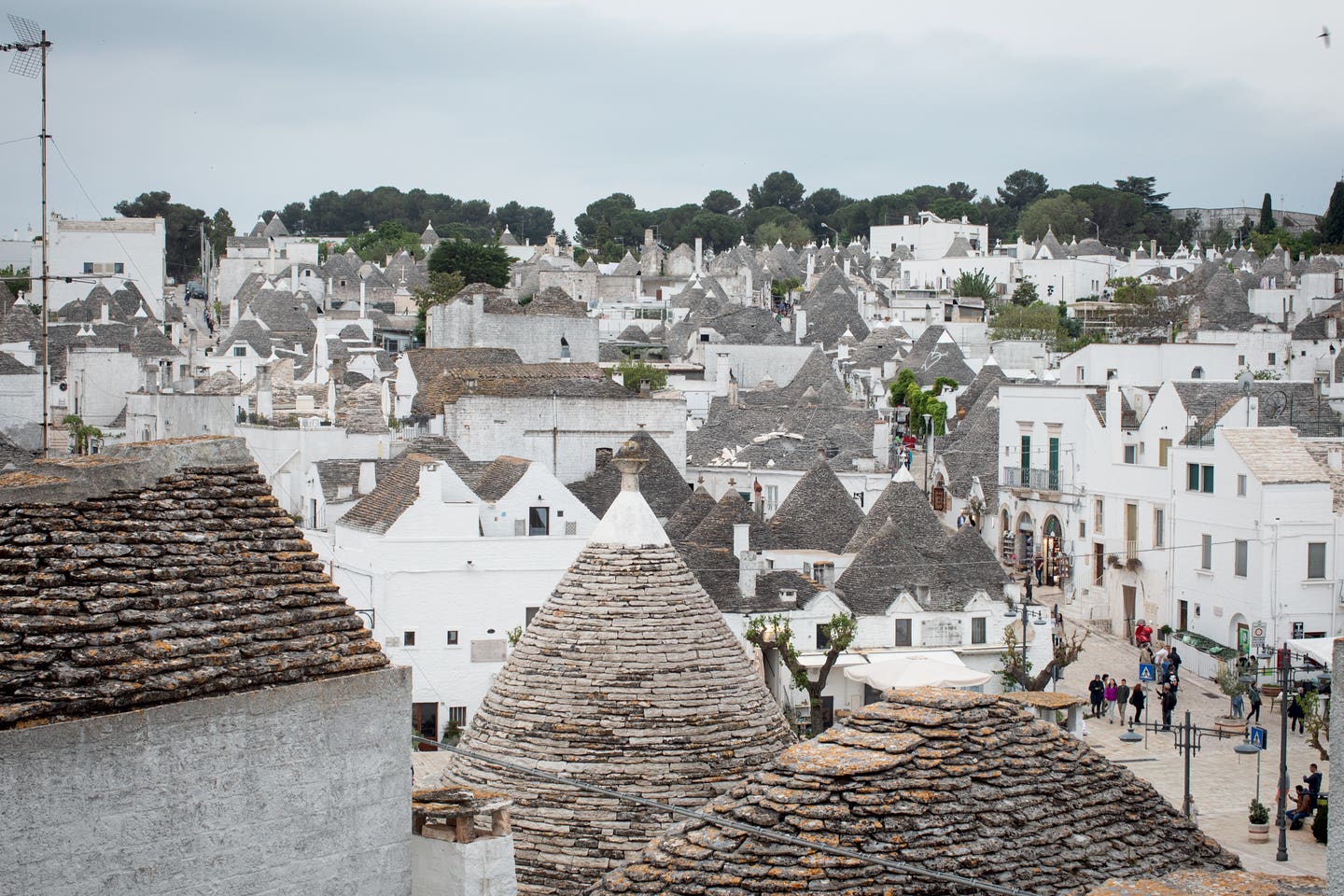
The Cuisine of Puglia Defies Definition
It’s easy to romanticize southern Italy, but as this region proves, tradition can coexist with novelty—and the food is all the better for it.
At the back of a butchery in the town of Martina Franca, Riccardo Ponte claps his massive, baseball-mitt hands, calloused from years of charcoal burns and judo holds, and presents the next plate. Tender chunks of veal lung wrapped in sinister layers of pork fat form a glistening pyramid on the table. “Pugliese chewing gum,” he says with a grin, before retreating back to his grill, a central fixture of his shop, called Mang e Citt, or “Sit Down and Eat” in Pugliese slang. Most of the macellerias—butchers that double as informal restaurants—have, out of convenience, moved to standard-issue flat-top grills in recent years. Ponte’s setup, however, is somewhere between a pizza oven and a hearth, a kind of infernal cubby hole carved directly into the wall of his small fluorescent-lit shop. Stacks of meat balance precariously on skewers; coals, dispersed in various piles, create heat zones measured purely by feel. Ponte insists that this technique, established centuries ago by the butchers of Martina Franca, makes all the difference: “You can taste the process,” he says.
I had come to Puglia—the gleaming, postcard-ready wedge of Southern Italy that sticks into the Ionian Sea like a boot heel—to eat. This, I recognize, is not a very original quest: Elizabeth Gilbert has been there, Stanley Tucci has done that. Spend enough time digging through guide books and suggested itineraries, and you’d be excused for thinking the only thing in Italy to do is eat.
When we travel to eat, though, we’re often looking for a story—a tale to bring back home, or a clear, easy-to-digest version of a place that fits squarely in our own mental atlases: The ruby red aperitivo glistening in the Tuscan sun, the trapizzino held aloft on the Spanish Steps, the pale green scoop of pistachio gelato, doled out in a Sicilian alleyway. Or, in Ponte’s case, the small-town, larger-than-life chef, seemingly grief-stricken by your physical inability to accept “just one more” piece of grilled meat.
It’s easy to arrive in a place like Puglia with pre-conceptions about Southern Italy: a hot, quiet place, where things move slowly and naps are plentiful. But I quickly learned that for every person doing something one way, there is someone else doing the very same thing—for the very same reasons—a completely different way. As one meal bled into the next, I found that every time I built a story out of the meals I ate and the people I met, every time I thought I had found some definitive sense of what Puglia actually tastes like, it quickly fell away.
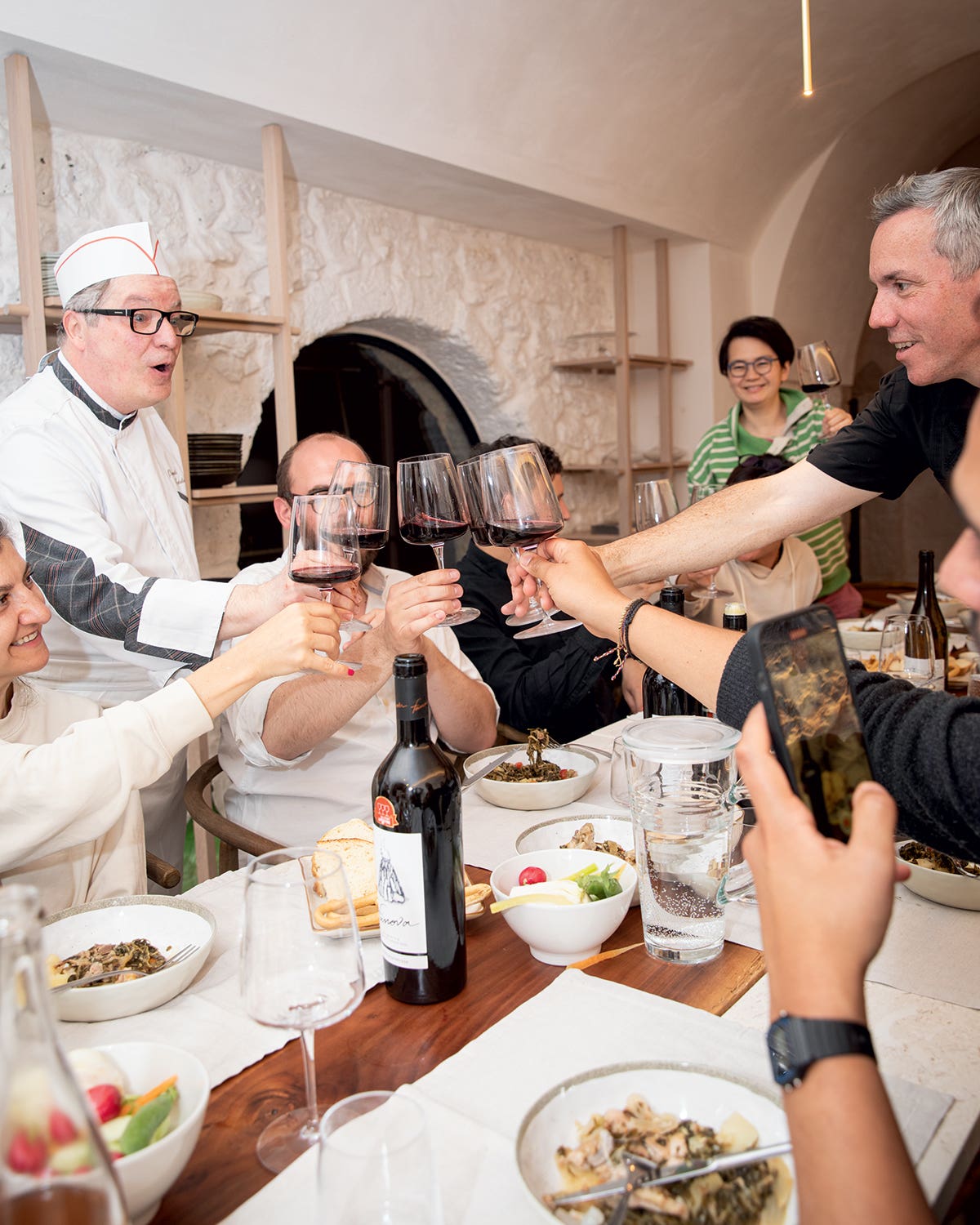
While I wish I could take credit for stumbling upon Ponte’s establishment, I was part of a tour group traveling through the region. Roads and Kingdoms, an online travel magazine, has, in recent years, pivoted toward offering small-group, food-centric trips around the world. Trips like the one I took to Puglia are focused not on big-name restaurants, but on offering a backstage pass to show travelers how the actual sausage gets made, drawing on what co-founder Nathan Thornburgh describes as “an archipelago of interesting people.”
If it all sounds vaguely Bourdainian, that’s not a coincidence. Founded in 2012 by Thornburgh and food writer Matt Goulding, the company and its journalism was for many years supported and funded by Anthony Bourdain. Today, Roads and Kingdoms’ trips actively try to avoid what Thornburgh refers to as “following the umbrella across the piazza.” Potential guests must undergo an interview process to make sure they’re a good fit for the group: Fighting couples and Michelin star-hunters have been turned away in the past.
Roads and Kingdoms’ shift toward this kind of “don’t-call-it-a-group-trip group trip” is indicative of a wider trend in travel, one in which access is everything. Whether helmed by chefs, academics, or journalists, experiences are being gently curated in a way that feels uniquely yours as they lodge themselves into your memory. Serendipity, by definition, can’t be manufactured. Oftentimes, the best partner to the unexpected is time—slow down and stretch out a trip and you’re bound to meet the characters and have the conversations that end up solidifying the travel experience in your mind. That’s harder on an organized tour, but, as these experiences seem to posit, not impossible.
The interesting person leading us on this particular trip was Eugenio Signoroni, one of Italy’s most celebrated food writers, as well as the editor of the hotly contested “Osterie d’Italia” guidebooks from Slow Food International’s publishing house, which list and review the best traditional restaurants across Italy. On day one, as golden hour sets in at the masseria, or farmhouse, that would serve as our base, Signoroni explains that this is a trip to shatter preconceptions, not confirm them. “You know the stories of the nonna, the Italian grandma and her amazing cooking?” he asks. “I want you to know it’s a total myth: My daughter’s grandmother doesn’t know how to cook a damn thing.” It was a good line for a tour built on this kind of punk-rock premise, but in talking to him afterwards, it became clear that the sentiment behind it is true.
“We like to build up this romantic idea of tradition,” Signoroni says when I ask what he notices when talking to first-time visitors to Italy. “It makes us feel safer and more comfortable.” Four years prior, when I visited Puglia for the first time, I had felt a kind of self-satisfied contentment: Sipping wine and watching a blacksmith working on new horseshoes for the stallions he kept behind his shop, the memory fits squarely into the romantic. “If we want to really understand a place,” Signoroni says, “we have to see it as it is, not as we think it should be.”
That doesn’t mean you won’t find intergenerational recipes and deep-seated heritage in Puglia. This is a place fiercely proud of its traditions, themselves a mishmash of the steady wave of conquerors who came to this land over millennia. It’s a pride that has been reinforced by recent history too, borne from decades of being looked down upon by the rest of the country. Long one of the poorest regions in Italy, Puglia was left behind by the industrialization that took hold in the north. As a result of a largely subsistence economy, cucina povera—literally “poor kitchen”—is the backbone of Pugliese cuisine. It’s only in recent years, as Puglia has marketed itself as a global destination, that the culinary label has been wielded not with shame, but with a kind of reclaimed dignity.
“You know the story of the Italian grandma and her amazing cooking? I want you to know it’s a total myth.”
At Cibus, a family-run restaurant tucked away in a labyrinth of climbing alleyways in the town of Ceglie Messapica, every dish reveals new layers of complexity that belies the kind of catch-all utilitarian implication of cucina povera. The Silibello family offers a crash course in the ingredients of the Salento region: Lampascioni, often translated as “bitter onion” but actually the bulb of a type of hyacinth, takes on the consistency of burnt newsprint when fried, yielding a bitterness that prepares the palate for what comes next. Stringy stracciatella cheese is teleported out of the heart of the burrata balls where it’s most often found, and spread out onto overflowing plates, to be eaten by the dripping forkful. Slices of capocollo and other cuts from the Apulo-Calabrese black pig are arranged into a gradient of richness with clear instructions on how to avoid blowing out your taste buds with hits of lard too early. To bring us back to earth, a Pugliese classic that emerged from tough times: fave e cicoria, a bed of mashed fava beans, topped with chicory leaves and lashed with olive oil. A ragù follows, made with tender horse meat and ricotta forte (an aged, barnyard-forward cheese with a long shelf life ideal for peasant pantries), and juicy, butter-soft slices of beef from the region’s Podolica cow, equally prized for its meat as for its milk.
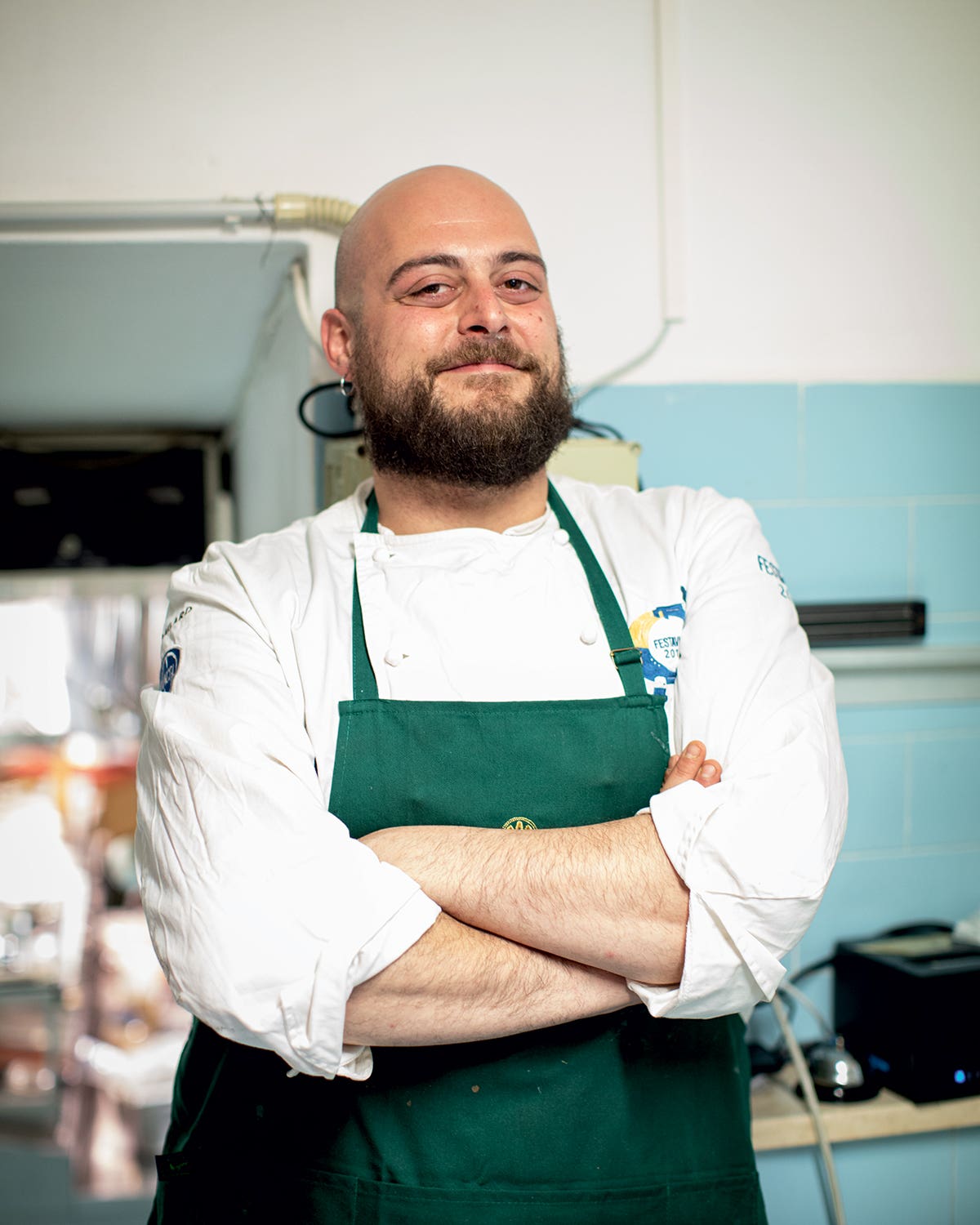
With its familial ambience, its focus on hearty, of-the-soil ingredients, and its secret, in-house cheese cave, Cibus is the kind of place most travelers dream about when they dream about Italy. And it is exactly as satisfying as you might imagine. Here, all of Signoroni’s “romantic ideas of tradition,” are confirmed to carry at least a foundation of reality. But just 30 miles away, in the town of Putignano, those vague notions of some idealized past are being intentionally—and ruthlessly—torn apart.
At Osteria Botteghe Antiche, chef Stefano D’Onghia takes many of the same ingredients—the same dishes, even—and brings them into a kind of parallel universe where what is known and established gives way to what there is left to learn. There is lampascioni here too, but it is accompanied by a kind of capocollo pocket, filled with chickpea purée. Fave e cicoria becomes a vague signpost rather than a cornerstone of tradition: The fava purée is stuffed into a single grilled green pepper and served alongside a spoonful of caramelized red onions. Ricotta makes an appearance, too, but it is imbued with mint and hidden within the delicate folds of a zucchini flower. Orecchiette, the ear-shaped pasta often served in Puglia with broccoli rabe, is made—intentionally, cheekily—with grano arso, burnt grain that for centuries was the only stuff available to the poorest of the poor. It shares the plate with indulgent chunks of grilled octopus, as if to say look how far we’ve come.
The next evolution of D’Onghia’s menu will be a push toward sustainability, something he argues is at the core of Puglia’s seemingly simple, local-first cuisine. “Nowadays it’s hard to sell a meat dish for less than 18 euros, which is strange for a region like Puglia,” D’Onghia told me. “I want to think about how to make cuts of meat that are not expensive—liver, tongue, offal—just as delicious.” He points to the octopus orecchiette as a dish that is becoming just too expensive for him to sell. What would it taste like, he wonders, if instead of serving the meat, he sous-vide cooked the octopus’s liver, a piece often discarded by fishermen? Somewhere, in someone’s imagined reality, a nonna in a sauce-streaked apron can’t believe her ears.
Other days highlight both the diversity of the gastronomic scene and the utter impossibility of fitting it into a neat package. There’s the pork cookout in the sun-slapped courtyard of a pig farm belonging to local producers Salumi Martina Franca. It lasts for hours, and transitions organically into a long walk through the land where the animals roam free. At Intini, an olive oil producer outside of Alberobello, a fourth-generation maker explains how some visitors are disappointed to see gleaming industrial equipment instead of charming wooden presses. “If I made it the traditional way, it wouldn’t be good,” Pietro Intini says. “The real revolution in olive oil production only happened 20 years ago.”
Even where traditions do remain intact, modernity creeps in. In Taranto’s Mare Piccolo, an inland sea, Luciano Carriero, a mussel farmer from a family of mussel farmers, explains how a tight-knit network of families has come together to create a cooperative, keeping the sticky fingers of organized crime away. As we float around the bay, he draws long necklaces of the bivalves out of the water and shucks them on the spot, to be eaten raw, paired with bites of provolone cheese and washed down with sparkling wine. He insists I try more than one. “It’s like a big box of chocolates,” Carriero says, one-upping Forrest Gump forever. “Each mussel tastes a little different.” That night, I follow his bounty to its final resting place at Antica Osteria la Sciabica, tucked away along a seaside promenade in the city of Brindisi. The seafood soup doubles as a taxonomy of marine life: fish, squid, shrimp, and, yes, mussels, all afloat in a rich, tomato-based broth. The restaurant buzzes with the sounds of spoons scraping the very last drops from drained bowls.
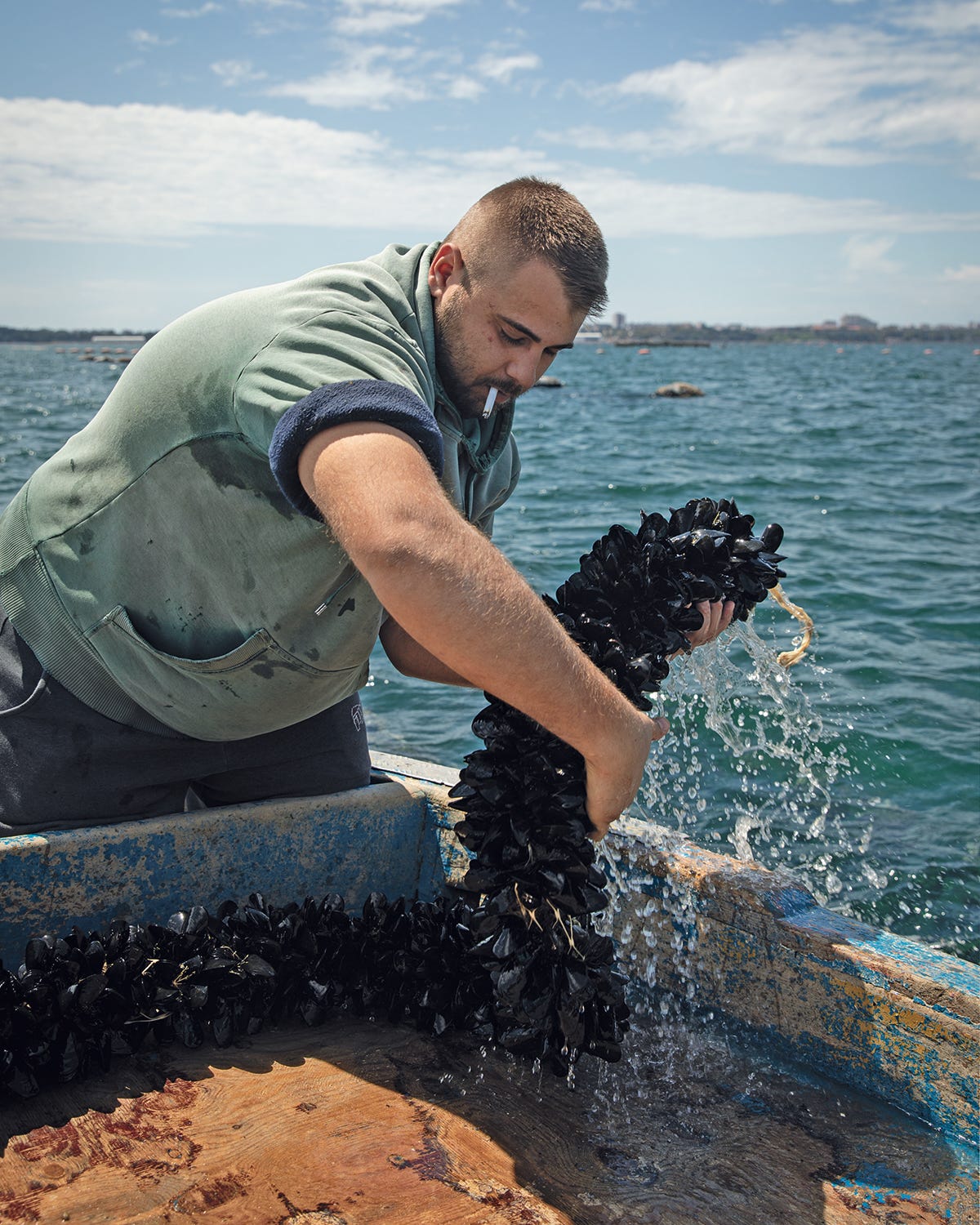
There is something about visiting the so-called “Old World” as a resident of the so-called “New” one that sets off a kind of rabid, voyeuristic urge to witness “tradition.” Some parts of Puglia, like the family-run cheese cave hidden under a bookshelf at Cibus, or the focaccerias in every village churning out flatbreads in the same oven for generations, do feel stuck in time, and I feel an almost involuntary delight whenever I encounter people doing things as they had been done since before Italy was Italy. But I soon find myself most looking forward to the moments of disruption. I had been warned, in a way, by Signoroni’s meditations on what we often expect from so-called “authentic experiences.” I had caught little rebellions in the form of culinary innovation, and in the subtle twisting of convention. But nothing, it was becoming clear, is that simple.
“Somewhere, in someone’s imagined reality, a nonna in a sauce-streaked apron can’t believe her ears.”
On the outskirts of Bari, in Altamura, I meet Vito Dicecca who, along with his siblings, has inherited the family cheesemaking tradition, which he treats with all the sacrosanct rulebook-abidance of a mad scientist. Out of a relatively small kitchen, the Dicecca family whips up around 800 pounds of lactic heresy every day. “Anyone in Puglia can make small cheese,” Dicecca says before pointing to his brother Paolo who is in the process of tying a mozzarella knot the size of a newborn. “I want to make big cheese.” He shows off a milky goat cheese concoction, best used as a dip for crispy bagel-shaped taralli crackers (“the best drunk food,” Dicecca calls it). A bright orange cousin to caciocavallo goes by the name “Life on Mars.” While conventional wisdom says mozzarella needs to be made from buffalo milk, the Dicecca family makes a goat milk version, granting the usually mild cheese a deliciously grassy funk.
To try Dicecca’s wildest creation, I have to wait until we leave the shop in Altamura and travel into the pinewoods of the Mercadante nature reserve. There, the family has opened Baby Dicecca, a cheese bar that serves as a tasting room and satellite for experimentation. After the kind of long, languorous meal I’ve grown accustomed to in Puglia, Dicecca brings out dessert. Looking more like a cake than a wheel of cheese, this has, for good reason, become the Diceccas’ most famous act of sacrilege. To create it, he drops a wheel of blue cheese into a barrel of primitivo wine, where it soaks for 100 days. Afterwards, it’s topped with candied sour cherries, adding a tartness to the indulgent sweet and salty combination. It’s cut into wedges that are intentionally about 12 times too big for one person to handle and served with even more primitivo wine. It’s called, Dicecca tells me with a conspiratorial grin, “Amore Primitivo.”
This, I think, seems like the kind of person who takes great pride in his inventions, who revels in the fact that he’s challenging tradition with each new wacky idea. Does he spend as much time thinking about authenticity as I do? “Are you worried someone is going to take your idea, or try to do some other, worse version of it?” I ask. I imagine grocery stores lined with tasteless, harmless cheeses, smothered in neon jelly.
“It doesn’t matter who invents the thing or who has the original story,” Dicecca says while doling out the next in an endless series of wine refills. “It only matters who does it best.”
Recipes
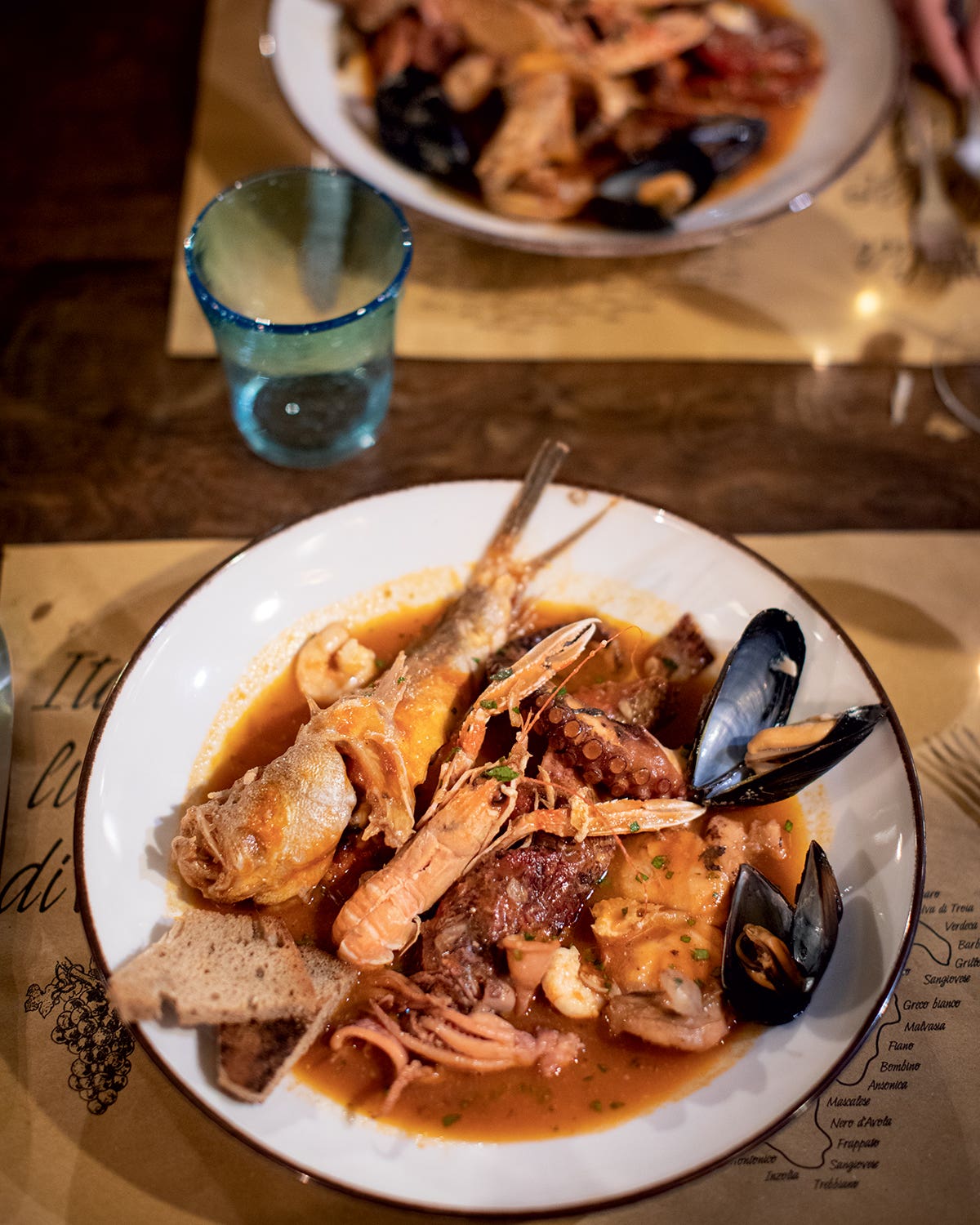
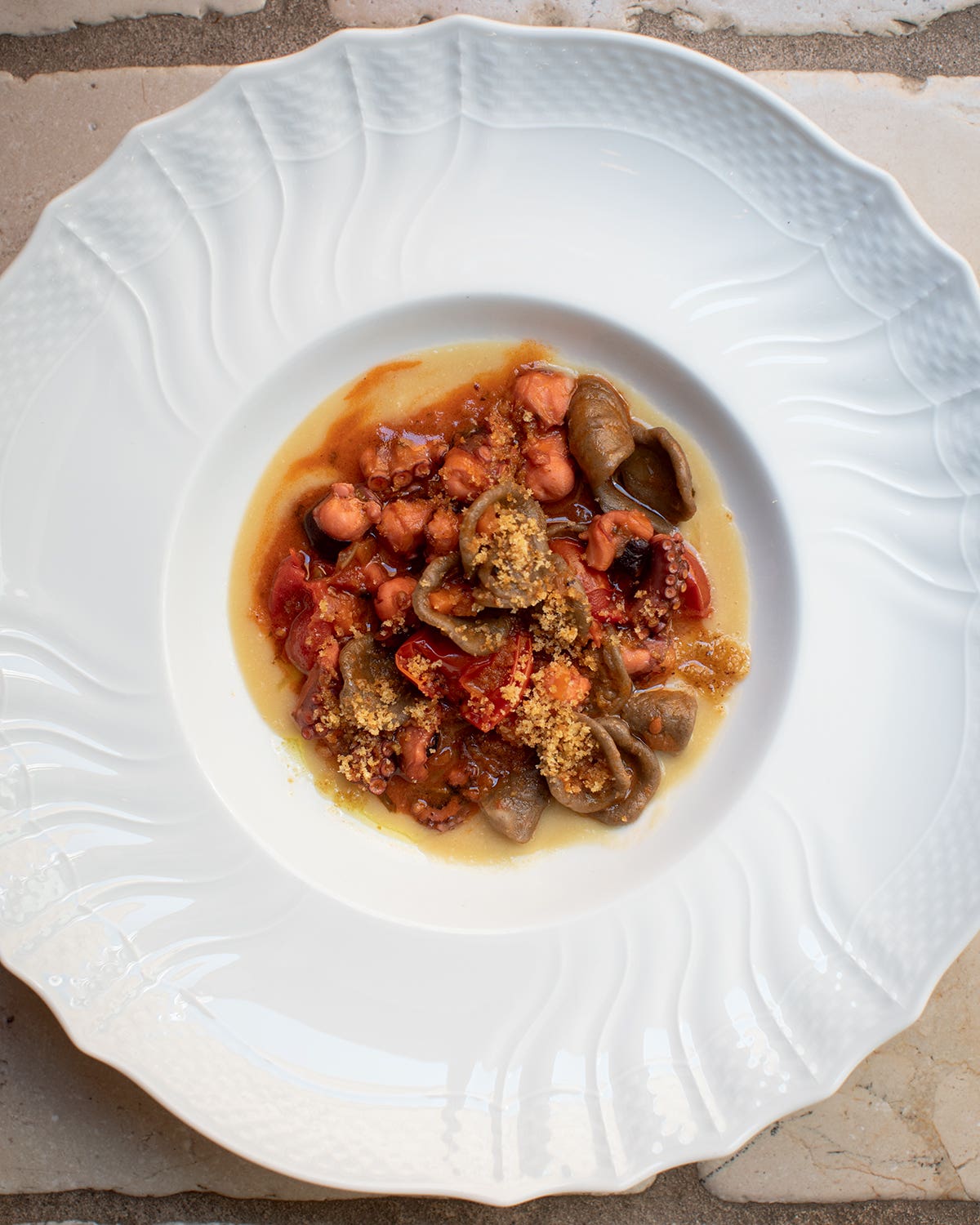
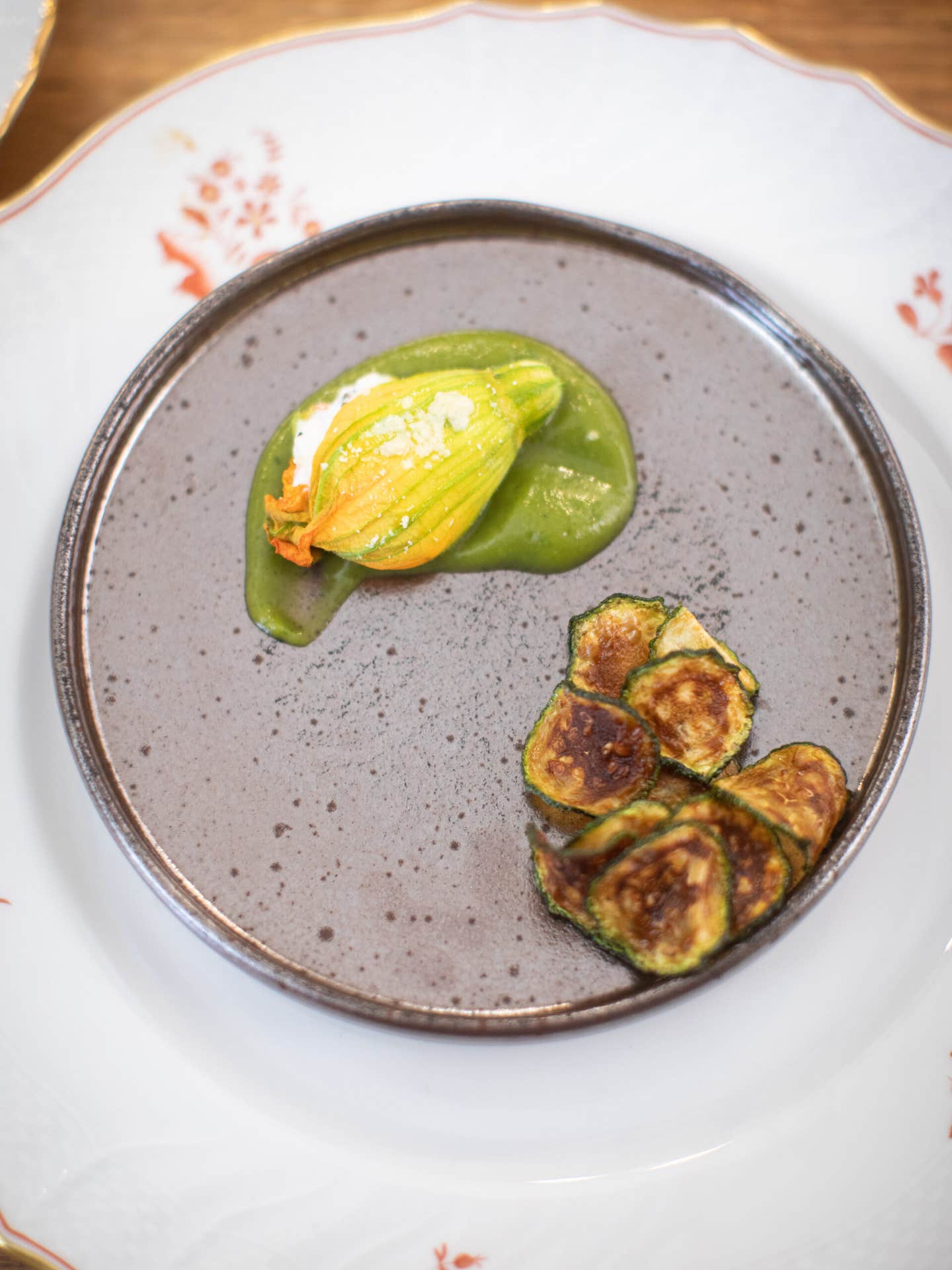
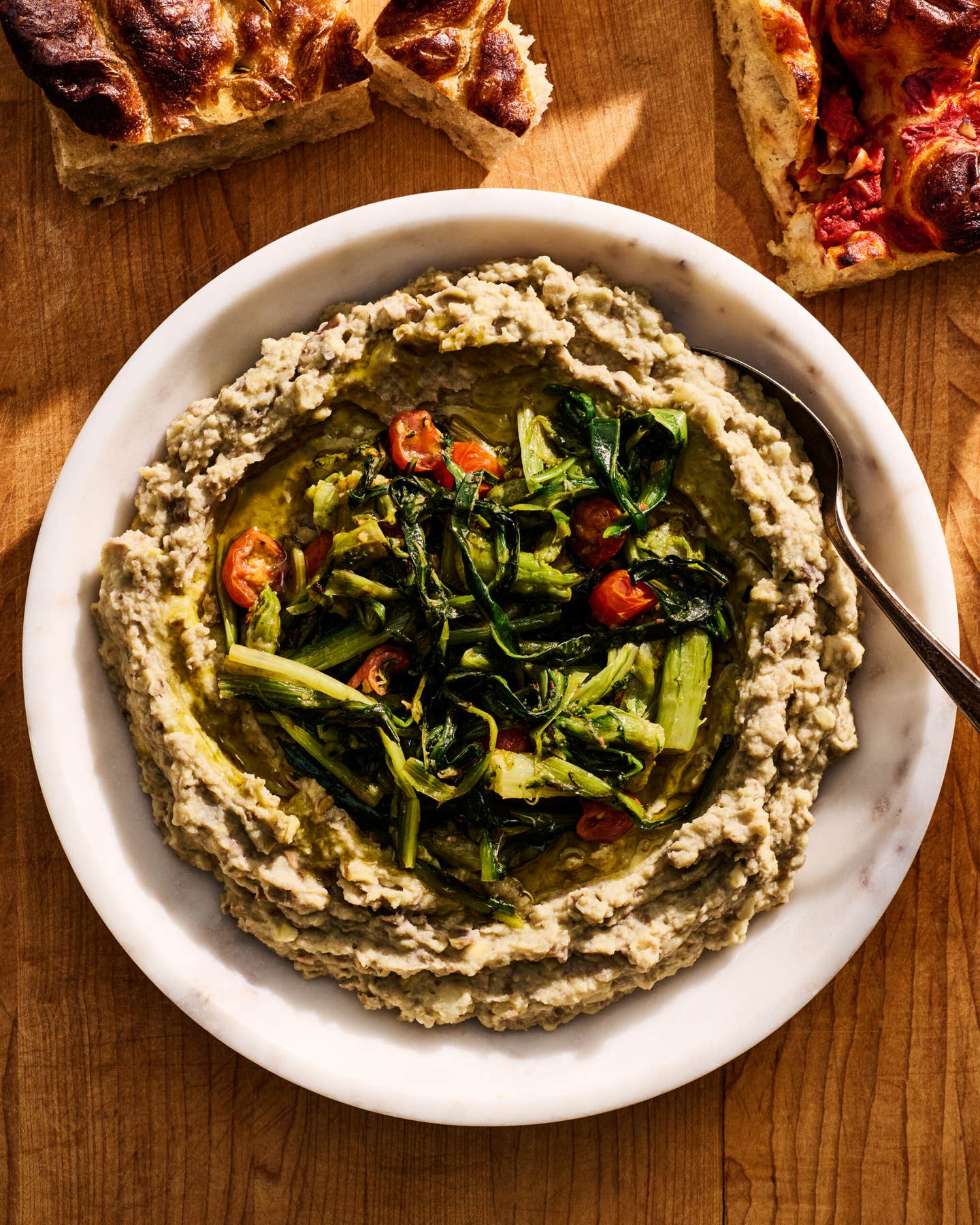
Keep Reading
Continue to Next Story










